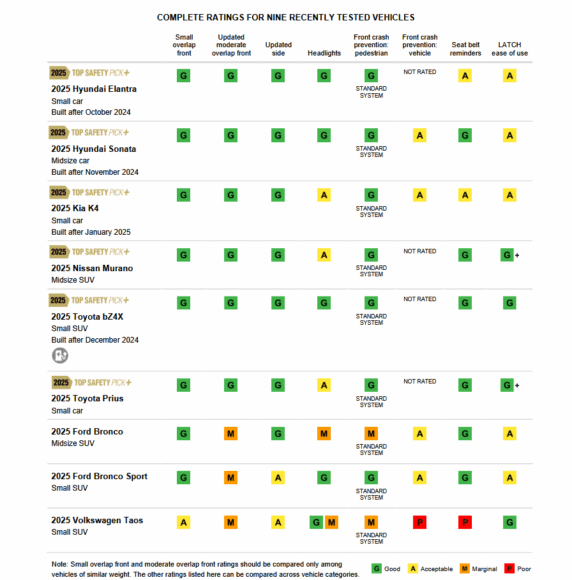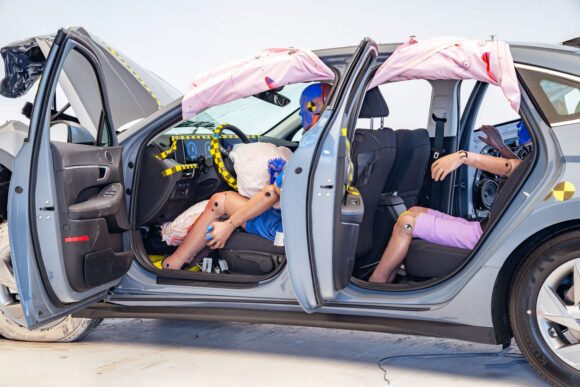The Insurance Institute for Highway Safety’s latest round of vehicle safety award winners include six vehicle models from four foreign automakers earning 2025 TOP SAFETY PICK+ awards in the latest batch of ratings.
The 2025 versions of the Hyundai Elantra, Kia K4, Toyota Prius, Hyundai Sonata, Toyota bZ4X and Nissan Murano all received the IIHS award.
For several vehicles, the award applies only to models built after a certain date, when their manufacturers made modifications to improve rear occupant protection. The award applies to Elantras built after October 2024, Sonatas built after November 2024 and K4s built after January 2025.
The Toyota bZ4X award is for vehicles built after December 2024, when the headlights on its XLE trim were changed to the current good-rated ones. Earlier XLE headlights earned a marginal rating, while the Limited trim always had good headlights.
To qualify for either the TOP SAFETY PICK+ or the lower-tier TOP SAFETY PICK awards, vehicles need good ratings in the small overlap front and updated side tests, an acceptable or good rating in the pedestrian front crash prevention evaluation and acceptable or good rated headlights across all trim levels. An acceptable rating in the updated moderate overlap front test is enough to qualify for TOP SAFETY PICK, but a good rating is required for the TOP SAFETY PICK+.

Joe Young, director of media relations for the IIHS, explained that the TOP SAFETY PICK award was introduced nearly two decades ago to give consumers an easy way to identify vehicles that excel in safety tests. As new tests have been introduced, the awards and criteria have routinely changed to incentivize automakers to make gradual improvements to their vehicles with the goal of earning these awards.
The 2025 TOP SAFETY PICK+ winners “truly reflect the safest vehicles available today,” Young said, noting that in addition to performing well in crash tests that reflect a variety of common real-world crash scenarios, all these award winners come with solid headlights and effective crash prevention technology.
The plus winners also earn the highest possible rating in IIHS’s newest crash test, the updated moderate overlap test, which was recently launched to get automakers thinking more about protecting people sitting in the second row of vehicles.
“As with all our tests, designing this test started with an examination of the real-world data,” Young explained. “In this case, our researchers found that the front seat had gotten much safer for occupants while improvements to the rear seats hadn’t kept pace. This test is aiming to change that, and we’re seeing quick improvements in the few short years we’ve been conducting the test.”
The IIHS moderate overlap crash test is the first consumer ratings test in the U.S. to incorporate a crash test dummy in the second row. For a vehicle to perform well, IIHS wants to see the restraint system do a good job of controlling the dummy’s movement while limiting belt forces that could cause chest or neck injuries, Young shared.
Some automakers have incorporated advanced belt technologies in the back seats to help with this. Belt pretensioners help ensure good position as a crash happens, while force limiters allow some slack in the belt to limit the amount of force on the chest. Young said these technologies have been standard in the front seats for years but were less common in the second row before this test was introduced.
Related: Annual List of Safest Cars for Teen Drivers
“In some cases, automakers are also looking at redesigning seats and belt anchorages to ensure the belt properly engages the occupant’s pelvis,” he added. “We’re also seeing adjustments to the curtain airbag to provide better coverage. All of these things add up to a more effective restraint system that will provide better crash protection for people in the back seats.”
Young said that the tests and ratings that IIHS produces provide a resource for consumers that are shopping for a new vehicle while pushing automakers forward in terms of safety improvements.
“None of that would be possible without the support of the auto insurance industry, and so I think it’s really important that claims professionals and others in the insurance industry understand the real impact that this support makes,” Young said.
The institute’s newest crash avoidance test, which will begin factoring in the TOP SAFETY PICK+ award criteria next year, targets several common rear-end crash scenarios. The new test evaluates how well vehicles can detect stopped motorcycles, large trucks and passenger cars at speeds up to 43 mph.
“As vehicle crash prevention technology continues to improve in these sorts of scenarios, we expect to see reductions in real-world rear-end crashes for vehicles that perform well,” Young said.
Top Photo: A 2025 Hyundai Sonata is shown after a crash, highlighting the activated airbags and damage to the occupant compartment. This model of Sonatas built after November 2024 earned a TOP SAFETY PICK+ award in the latest batch of Insurance Institute for Highway Safety ratings. (Photo Contributed by IIHS).
Was this article valuable?
Here are more articles you may enjoy.


 Insurance AI Demo Day Calendar Announced
Insurance AI Demo Day Calendar Announced  Abbott Presses Congress for Shield Over Preemie Baby Formula Litigation That Could Cost It Billions
Abbott Presses Congress for Shield Over Preemie Baby Formula Litigation That Could Cost It Billions  J&J Talc Jury Awards $1.56 Billion to Asbestos Cancer Victim
J&J Talc Jury Awards $1.56 Billion to Asbestos Cancer Victim  Cat Bonds Linked to Wildfires Lose ‘Once Untouchable’ Status
Cat Bonds Linked to Wildfires Lose ‘Once Untouchable’ Status 